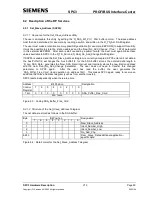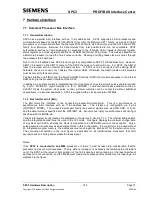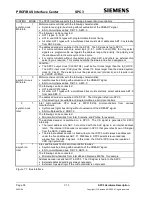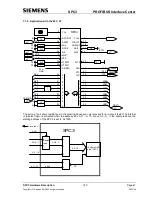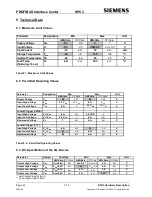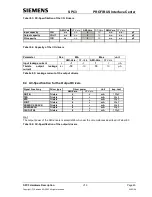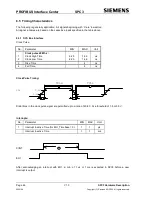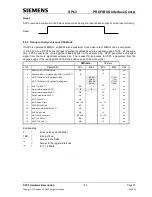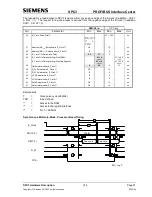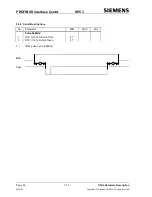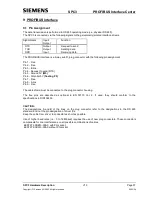
SPC3
PROFIBUS Interface Center
SPC3 Hardware Description
V1.3
Page 43
Copyright (C) Siemens AG 2003 All rights reserved.
2003/04
7.1.6 Interface Signals
The data bus outputs are high-resistance during the reset phase. All outputs are switched to high-resistance
in the test mode. (See block test.)
Name
Input/
Output
Type
Comments
DB(7..0)
I/O
Tristate
High-resistance for RESET
AB(10..0)
I
AB(10) has a pull down resistor.
MODE
I
Setting: syn/async interface
XWR/E_CLOCK I
Intel: Write /Motorola: E-Clk
XRD/R_W
I
Intel: Read /Motorola: Read/Write
XCS
I
Chip Select
ALE/AS
I
Intel/Motorola: Address Latch Enable
DIVIDER
I
Scaling factor 2/4 for CLKOUT 2/4
X/INT
O
Tristate
Polarity programmable
XRDY/XDTACK O
Tristate
Intel/Motorola: Ready-Signal
CLK
I
48 MHz
XINT/MOT
I
Setting: Intel/Motorola
CLKOUT2/4
O
Tristate
24/12 MHz
RESET
I
Schmitt-Trigger Minimum of 4 clock pulse cycles
Figure 7.2: Microprocessor Bus Signals
7.2 UART
The transmitter converts the parallel data structure into a serial data flow. Request-to-Send (RTS) is
generated before the first character. The XCTS input is available for connecting a modem. After RTS
active, the transmitter must hold back the first telegram character until the XCTS modem activates.
The receiver converts the serial data flow into the parallel data structure. The receiver scans the serial data
flow with the four-fold transmission speed. Stop bit testing can be switched off for test purposes
(„DIS_STOP_CONTROL = 1“, in mode register 0 or ‘Set_Param-Telegram’ for DP). One requirement of the
PROFIBUS protocol is that no rest states are permitted between the telegram characters. The SPC3
transmitter ensures that this specification is maintained. This following start bit test is switched off with the
parameter setting „DIS_START_CONTROL = 1“ (in mode register 0 or ‘Set_Param telegram’ for DP).
Specified by the four-fold scan, a maximum distortion of the serial input signal of X = -47% to y = +22% is
permissible.
7.3 ASIC Test
All output pins and I/O pins can be switched in the high-resistance state via the XTESTO test pin. An
additional XTEST1 input is provided (more information upon request) to test the block internally with test
automatic devices (not in the target hardware environment!).
Pin No. Name
Function
34
XTEST0
VSS (GND) All outputs high-resistance
VDD (+5V)
Normal SPC3 function
35
XTEST1
VSS (GND) Various test modes
VDD (+5V)
Normal SPC3 function
Figure 7.3: Test Support
XTEST0 and XTEST1 must be placed on V
DD
(+5V) via external pull-up resistors.
Summary of Contents for SPC3
Page 1: ...SIMATIC NET SPC3 Siemens PROFIBUS Controller Hardware Description Date 2003 04 09 ...
Page 2: ......
Page 67: ......

